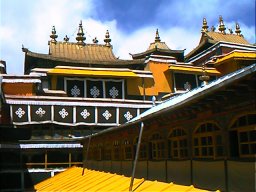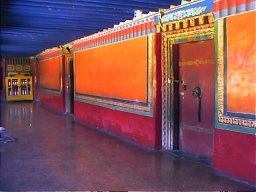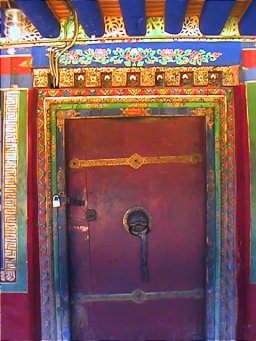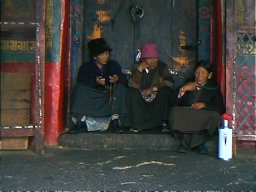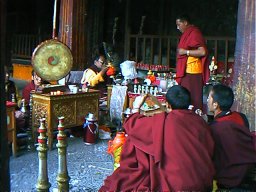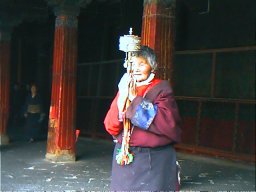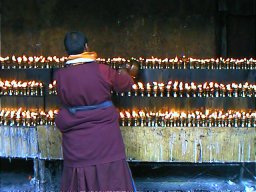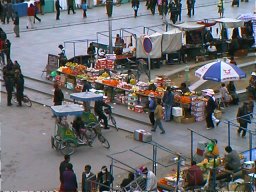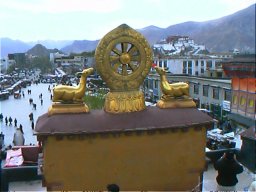|
All images and text are copyright protected. Contact
|
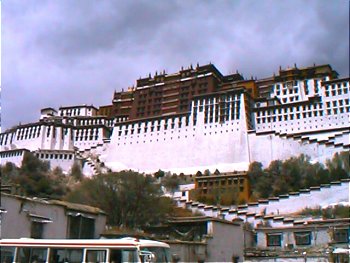 Lhasa Arriving in Lhasa, my first feelings are, "At long last, I'm here. I've waited ten years for this moment." My first impressions of Lhasa are, "Where are we? Is this Lhasa?" It looks like Guangzhou or Nanning or any big Chinese town for that matter. Ganzi, Kangding or Peiyul in Sichuan, which used to lie within the province of Kham in Greater Tibet, looks more Tibetan that this. I look for the Potala, some landmark that would tell me that I really am in Lhasa. We drive along roads with grey factories, shops and traffic very much like in Nanning. Sometimes there are telltale signs: a Tibetan in Chinese clothes would drive past in a tractor, his cheeks reddened by the weather, or a group of raffish Tibetan youths with longish hair would be leaning against the railings at the roadside. A few blocks further on and someone cries out, "There, the Potala!"
We turn away from it toward our hotel and I get just a glimpse before it disappears. Our hotel is solid Tibetan, in the Old City near Barkhor Square, and has a Tibetan name, Banakshol, which I have problems remembering. The name on the sign in front is in Chinese characters, Ba Lang Xue, and that is how I think of it, only by the Chinese name, which is a pity since, in my little way, I am helping to strip Lhasa of her Tibetan culture. Nights here are cold. It snows on my first night and every night, going out for dinner, I put on my thermals and winter clothes.
The coronation hall is small, ornate, with gifts of calligraphy by emperors and sacred, historical tapestry hangings. Nowhere is there any sign of damage; I am surprised that the Potala and its contents were not destroyed during the Cultural Revolution. Though the Potala is atmospheric with incense smoke, gloomy rooms and treasures, yet it is like a gilded birdcage after the bird has flown. I didn't know what to expect; perhaps monks fingering their chinga or beads, Khamba men wearing their chubas with the right sleeve hanging to the ground, yaks in the streets – these were common sights in Sichuan and Qinghai but not here in Lhasa. I expected that all the monks would have fled to Nepal and India leaving their monasteries to become tourist attractions. On Dongfeng Road, a slightly disheveled middle-aged Tibetan man walking alongside me strikes up a conversation. He is, he says, an architect of Tibetan monasteries currently working in a village some distance away. I point out a deserted monastery across the road and ask if it is still functioning. "Only as a warehouse for the government," he says. "Are there any living monasteries in Lhasa?" I ask. "Yes, the Jokhang."
The Potala was the home of the Dalai Lama, the seat of government, a monastery. The Jokhang was the place of worship. Today, while the Potala's neighbourhood has been modernized, the Jokhang and its surrounding Barkhor Square remains as it did before 1950. It is busy with monks chanting sutras, ringing bells, bashing cymbals, blowing trumpets and conch shells; lighting yak butter candles; old people twirling prayer wheels; people prostrating themselves full length on the ground.
Inside are the main prayer hall and several chambers with shrines to Buddhas and Boddhisattvas, each in its own cell, some with a chain net door, the air thick with fragrant incense and, everywhere, glimmering butter candles. This is the Tibet from another age, old Tibet.
"There are no buses to Yunnan," they say. "Will I be allowed to travel by truck to Yunnan?" I ask. "No. You can fly to Chengdu." "I don't want to fly," I say. "You can take the bus to Chengdu." "I don't want to go all the way to Chengdu. Can I get off the bus before the Sichuan border and go south into Yunnan?" "The bus doesn't go east. It goes north to Golmud, through Gansu, then south to Chengdu." They are describing a huge arc that goes in the opposite direction to mine. Only the Chinese could make a suggestion that goes completely counter to one's wishes and expect it to be acceptable. It reminds me of the enormous hassles (which often spells expense) of everyday life in China. Suddenly I wonder, why am I going back to China? There are other countries, which are much less troublesome. I am surprised that a major decision has been made so easily but, actually, the decision was made for me. I go back into town in search of a jeep returning to Nepal. Downtown Lhasa is new and looks like a Chinese town with boutiques, shops and large department stores. At the Yak Hotel I find a travel agent, Mr Dho Kho, with a Land Cruiser going to Zhangmu on the Nepalese border. "We have a Jeep leaving now," he says. "Can I see the Jeep?" I ask "Do you want to leave on it?" he asks. "I can't leave now," I say. "Tomorrow." "Well, you can't see it. The Jeep has gone," he says. It's very suspicious, but I have no choice and I put down a deposit. For my last meal in Lhasa I join my traveling friends for dinner at Dunya Restaurant. The owners are almost all expatriates living in Lhasa for between two to five years. The restaurant is exceptionally well run and the staff is polite, helpful and efficient. The menu is broad: Tibetan, Chinese and western for which I am grateful. It is ill-rumored that the Tibetans were happy for the Chinese invasion so they could have a change from the tsampa (a paste made from roasted barley, yak butter and tea). In the former Greater Tibet regions and the present Tibet Autonomous Region, I had eaten tsampa, yak burgers, momos, very bland thukpa (Tibetan noodle soup) and mutton soup with rice which the burly Khambas wolfed down and which tasted uncooked, and while they were tasty I couldn't say that I was fond of them; they may be an acquired taste. So while I must consider that rumour to be untrue, I can see how it got started.
In the morning I turn up at the Yak Hotel for my Jeep which is a fairly new Land Cruiser. I hoist my backpack in the back and greet Mr Dho Kho. "How many passengers will be going?" I ask. It is well known among travelers that these Jeeps pack in as many as possible to the discomfort of the passengers or that the Jeeps abandon the passengers in mid-journey. Dho Kho looks angry. "You can see the Jeep holds five passengers." "How many do we have today?" "We have two." "What happens if the Jeep breaks an axle on the journey?" I ask. "I have seen cars with broken axles on the road." "Then you will be left there on the road. Also if you give trouble, I can promise you that the driver will put you out." He sounds very angry. "And if I must get another Jeep to take me the rest of the way, who then must pay?" I persist. Dho Kho pulls my backpack from the back of the Jeep, throws it on the ground and says, "You're too late. You must find another Jeep." I struggle to keep my temper and walk away to sit on the steps. I need to leave Lhasa soon and do not have time to look for another Jeep. The driver replaces my luggage in the back and after another hour we depart Lhasa. Raceandhistory.com | Howcomyoucom.com | Trinicenter.com | TriniView.com Another 100% non-profit Website serving poorly represented communities. Copyright & Disclaimer. - - Privacy Policy --Designed & maintained by S.E.L.F. © 2002 TriniView.com |

